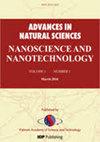Fucoidan and dendrimer-based nanocapsule exhibiting effectiveness in methotrexate controlled delivery towards rheumatoid arthritis treatment
IF 2.1
Q3 MATERIALS SCIENCE, MULTIDISCIPLINARY
Advances in Natural Sciences: Nanoscience and Nanotechnology
Pub Date : 2023-11-16
DOI:10.1088/2043-6262/ad09c6
引用次数: 0
Abstract
In recent years, nanomaterials have been intensively studied and applied in various fields, including pharmaceutical applications. This platform can act as a carrier for anticancer drugs or for insoluble bioactive compounds. To increase the stability and prolong the effect of anticancer drugs, we have incorporated a sulfated polysaccharide fucoidan (Fu) into PAMAM dendrimer G3.0 to form a G3.0-Fu complex. Then, a nano-sized encapsulated anticancer drug, methotrexate (MTX), was successfully embedded in the synthesised dendrimer complex namely G3.0-Fu/MTX. Newly synthesised G3.0-Fu/MTX was characterised by transmission electron microscopy (TEM), dynamic light scattering (DLS), and zeta potential measurement.Additionally, the loading efficiency of MTX was assessed via UV spectroscopy. Our findings revealed that upon combining with Fu, the G3.0 nanoparticle size increased from 4.3 ± 1.1 nm to 56 ± 6 nm. The changes in zeta potential aligned with drug entrapment efficiency and the results from TEM and DLS. The drug release activity of G3.0-Fu/MTX was increased compared to free MTX after 24 h. G3.0-Fu also showed high cytocompatibility in fibroblast cells. Taken together, the G3.0-Fu could be used to increase the encapsulation of several kinds of hydrophobic drugs and G3.0-Fu/MTX could be further studied in rheumatoid arthritis treatment.基于褐藻糖胶和树枝状聚合物的纳米胶囊在类风湿性关节炎治疗中显示出甲氨蝶呤控制递送的有效性
近年来,人们对纳米材料进行了深入研究,并将其应用于各个领域,包括医药应用。该平台可作为抗癌药物或不溶性生物活性化合物的载体。为了提高抗癌药物的稳定性并延长其药效,我们将硫酸化多糖褐藻糖胶(Fu)加入到 PAMAM 树枝状聚合物 G3.0 中,形成 G3.0-Fu 复合物。然后,在合成的树枝状聚合物复合物(G3.0-Fu/MTX)中成功包埋了纳米级抗癌药物甲氨蝶呤(MTX)。新合成的 G3.0-Fu/MTX 通过透射电子显微镜(TEM)、动态光散射(DLS)和 zeta 电位测量进行了表征。我们的研究结果表明,与 Fu 结合后,G3.0 纳米粒子的尺寸从 4.3 ± 1.1 nm 增加到 56 ± 6 nm。zeta 电位的变化与药物包埋效率以及 TEM 和 DLS 的结果一致。与游离 MTX 相比,G3.0-Fu/MTX 的药物释放活性在 24 小时后有所提高。G3.0-Fu 在成纤维细胞中也表现出较高的细胞相容性。综上所述,G3.0-Fu 可用于提高多种疏水性药物的包封性,G3.0-Fu/MTX 在类风湿性关节炎治疗中的应用有待进一步研究。
本文章由计算机程序翻译,如有差异,请以英文原文为准。
求助全文
约1分钟内获得全文
求助全文
来源期刊

Advances in Natural Sciences: Nanoscience and Nanotechnology
NANOSCIENCE & NANOTECHNOLOGYMATERIALS SCIE-MATERIALS SCIENCE, MULTIDISCIPLINARY
自引率
4.80%
发文量
0
 求助内容:
求助内容: 应助结果提醒方式:
应助结果提醒方式:


